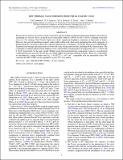| dc.contributor.author | Torrejón, J. M. | |
| dc.contributor.author | Testa, P. | |
| dc.contributor.author | Rodes, J. J. | |
| dc.contributor.author | Nowak, Michael A. | |
| dc.contributor.author | Schulz, Norbert S. | |
| dc.date.accessioned | 2015-01-29T18:56:38Z | |
| dc.date.available | 2015-01-29T18:56:38Z | |
| dc.date.issued | 2013-02 | |
| dc.date.submitted | 2012-07 | |
| dc.identifier.issn | 0004-637X | |
| dc.identifier.issn | 1538-4357 | |
| dc.identifier.uri | http://hdl.handle.net/1721.1/93203 | |
| dc.description.abstract | We present an analysis of a series of four consecutive Chandra high-resolution transmission gratings observations, amounting to a total of 150 ks, of the Be X-ray source HD 119682 (=1WGA J1346.5–6255), a member of the new class of γ Cas analogs. The Chandra light curve shows significant brightness variations on timescales of hours. However, the spectral distribution appears rather stable within each observation and during the whole campaign. A detailed analysis is not able to detect any coherent pulsation up to a frequency of 0.05 Hz. The Chandra High Energy Transmission Gratings spectrum seems to be devoid of any strong emission line, including Fe Kα fluorescence. The continuum is well described with the addition of two collisionally ionized plasmas of temperatures kT ≈ 15 keV and 0.2 keV, respectively, by the apec model. Models using photoionized plasma components (mekal) or non-thermal components (powerlaw) give poorer fits, providing support for the pure thermal scenario. These two components are absorbed by a single column with N H = (0.20[superscript +0.15] –0.03) × 10[superscript 22] cm[superscript –2] compatible with the interstellar value. We conclude that HD 119682 can be regarded as a pole-on γ Cas analog. | en_US |
| dc.description.sponsorship | Spain. Ministerio de Ciencia e Innovación (Grant AYA2010-15431) | en_US |
| dc.description.sponsorship | Spain. Ministerio de Ciencia e Innovación (Grant AIB2010DE-00057) | en_US |
| dc.language.iso | en_US | |
| dc.publisher | IOP Publishing | en_US |
| dc.relation.isversionof | http://dx.doi.org/10.1088/0004-637x/765/1/13 | en_US |
| dc.rights | Article is made available in accordance with the publisher's policy and may be subject to US copyright law. Please refer to the publisher's site for terms of use. | en_US |
| dc.source | American Astronomical Society | en_US |
| dc.title | HOT THERMAL X-RAY EMISSION FROM THE Be STAR HD 119682 | en_US |
| dc.type | Article | en_US |
| dc.identifier.citation | Torrejón, J. M., N. S. Schulz, M. A. Nowak, P. Testa, and J. J. Rodes. “HOT THERMAL X-RAY EMISSION FROM THE Be STAR HD 119682.” The Astrophysical Journal 765, no. 1 (February 11, 2013): 13. © 2013 The American Astronomical Society | en_US |
| dc.contributor.department | MIT Kavli Institute for Astrophysics and Space Research | en_US |
| dc.contributor.mitauthor | Nowak, Michael A. | en_US |
| dc.contributor.mitauthor | Schulz, Norbert S. | en_US |
| dc.relation.journal | Astrophysical Journal | en_US |
| dc.eprint.version | Final published version | en_US |
| dc.type.uri | http://purl.org/eprint/type/JournalArticle | en_US |
| eprint.status | http://purl.org/eprint/status/PeerReviewed | en_US |
| dspace.orderedauthors | Torrejón, J. M.; Schulz, N. S.; Nowak, M. A.; Testa, P.; Rodes, J. J. | en_US |
| mit.license | PUBLISHER_POLICY | en_US |
| mit.metadata.status | Complete | |
